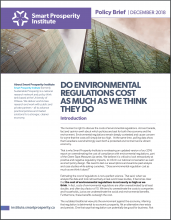December 5, 2018
The moment is right to discuss the costs of environmental regulations. Across Canada, fact and opinion swirl about which policies are best for both the economy and the environment. Environmental regulations remain deeply contested and cause concern for some that the costs will simply be too high. At the same time, polling data show that Canadians overwhelmingly want both a protected environment and a vibrant economy.
That is why Smart Prosperity Institute is re-releasing an updated version of our 2016 policy brief on overestimating the cost of compliance with environmental regulations, part of the Green Tape Measures Up series. We believe it is critical to look retroactively at positive and negative regulatory impacts, to inform our national conversation as well as smart policy design. We need to test our assumptions and examine past analysis and case studies while asking ourselves, “Do environmental regulations cost as much as we think they do?”
Key Findings
- There has been a persistent argument against environmental regulations on the basis that the compliance costs to regulated firms and industries are too high; however, evidence shows that the cost of complying with environmental regulations are often overestimated.
- Moreover, a review of the existing literature highlights the large net benefits (benefits significantly outweighing costs) of environmental regulations in most cases. The costs of regulations are more than offset by a broad range of economic, health, greenhouse gas (GHG) and other benefits.
- Estimates of anticipated costs made prior to the regulation’s implementation have sometimes been much greater – even double, and sometimes as much as 10 times greater (or more) – than the realised costs.
- There are a number of factors which contribute to the persistence of ex ante overestimates of compliance costs. One of these is the inability to capture the potential to innovate in response to regulations. Another is challenges in identifying baselines or control groups. A third factor is the lack of accounting for flexibility provisions incorporated into regulatory design, which are sometimes added or changed at a later stage of the regulatory process.
- Five case studies provide evidence of how compliance costs of individual regulations have often been overestimated in Canada and the United States: the Light Duty Vehicle Greenhouse Gas Emissions and Standards; Sulphur in Gasoline Regulations; the Acid Rain program; the Montreal Protocol; and the Clean Air Act.
- There is very limited public analysis on realised or ex-post compliance costs of Canadian environmental regulations, and improved efforts in this area would be particularly beneficial for improving evidence-based policy advice.





